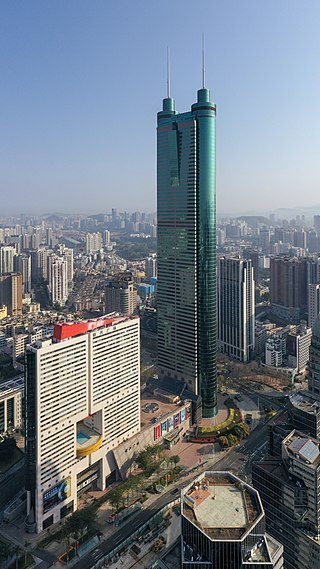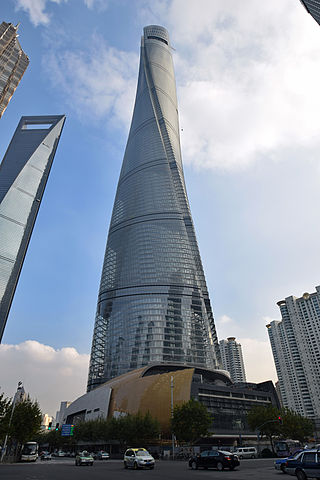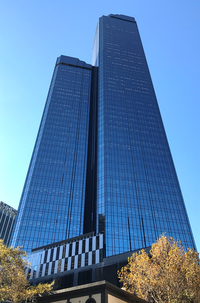Eureka Tower is a 297.3 m (975 ft) skyscraper located in the Southbank precinct of Melbourne, Victoria, Australia. Construction began in August 2002 and the exterior was completed on 1 June 2006. The plaza was finished in June 2006 and the building was officially opened on 11 October 2006. The project was designed by Melbourne architectural firm Fender Katsalidis Architects and was built by Grocon. The developer of the tower was Eureka Tower Pty Ltd, a joint venture consisting of Daniel Grollo (Grocon), investor Tab Fried and one of the Tower's architects Nonda Katsalidis. It was the world's tallest residential tower when measured to its highest floor, until surpassed by Ocean Heights and the HHHR Tower in Dubai. From 2006 to 2020, it was the tallest building in Melbourne, until the topping out of Australia 108. It is currently the third tallest building in Australia, behind the Q1 in Queensland and Australia 108, as well as the second tallest to roof behind the latter skyscraper. As of 2016 it was the 15th tallest residential building in the world.

Sydney Tower is the tallest structure in Sydney, Australia, and the second-tallest observation tower in the Southern Hemisphere. It has also been known as Centrepoint Tower, AMP Tower, and colloquially as Flower Tower, Glower Tower, and Big Poke.

Q1 Tower is a 322.5-metre (1,058 ft) supertall skyscraper in Queensland, Australia. The residential tower on the Gold Coast was the world's tallest residential building from 2005 to 2011. As of September 2022, it is the 14th tallest residential tower in the world, the tallest building in Australia, the second tallest building in the Southern Hemisphere, and the third-tallest free-standing structure in the Southern Hemisphere, behind the Autograph Tower in Jakarta, Indonesia, and the Sky Tower in Auckland, New Zealand. The Q1 officially opened in November 2005.

Shun Hing Square, also known as "Di Wang Tower" is a 384-meter (1,260 ft)-tall skyscraper in Shenzhen, Guangdong province, China. Upon its completion in 1996, it became the tallest building in China, until being surpassed by CITIC Plaza next year.

120 Collins Street is a 265 m (869 ft) skyscraper in Collins Street, Melbourne central business district, Victoria, Australia. It was built from 1989 to 1991 and it comprises 50 levels of office accommodation and four levels of plant.

The Central Radio & TV Tower is a 405-metre-tall (1,329 ft) telecommunications- and observation tower in Beijing, China. It was the tallest structure in the city until 2018, when it was surpassed by China Zun. It is the ninth-tallest tower in the world, and has its observation deck at 238 m (781 ft). The tower provides panoramic views over the city from its revolving restaurant and observation deck. It is a member of the World Federation of Great Towers.

Collins Street is a major street in the central business district of Melbourne, Victoria, Australia. It was laid out in the first survey of Melbourne, the original 1837 Hoddle Grid, and soon became the most desired address in the city. Collins Street was named after Lieutenant-Governor of Tasmania David Collins who led a group of settlers in establishing a short-lived settlement at Sorrento in 1803.

Nakheel Tower was a planned skyscraper on hold in Dubai, United Arab Emirates by developer Nakheel. The project was previously called Al Burj.

Australia Square Tower is an office and retail complex in the central business district of Sydney. Its main address is 264 George Street, and the Square is bounded on the northern side by Bond Street, eastern side by Pitt Street and southern side by Curtin Place.

101 Collins Street is a 260 m (850 ft) skyscraper located in Collins Street, Melbourne central business district, Victoria, Australia. The 57-storey building designed by Denton Corker Marshall was completed in March 1991. Towards the end of project, with a change of developer, the foyer space was designed by John Burgee, noted as a pioneer of postmodern architecture.

Shanghai Tower is a 128-story, 632-meter-tall (2,073 ft) megatall skyscraper in Lujiazui, Pudong, Shanghai. It is the tallest building in China and the world's third-tallest building by height to architectural top. It is the tallest and largest LEED Platinum certified building in the world since 2015. It shares the record of having the world's highest observation deck within a building or structure at 562 m. It had the world's second-fastest elevators at a top speed of 20.5 meters per second until 2017, when it was surpassed by the Guangzhou CTF Finance Center, with its top speed of 21 meters per second. Designed by international design firm Gensler and owned by the Shanghai Municipal Government, it is the tallest of the world's first triple-adjacent supertall buildings in Pudong, the other two being the Jin Mao Tower and the Shanghai World Financial Center. Its tiered construction, designed for high energy efficiency, provides nine separate zones divided between office, retail and leisure use.

Brookfield Place is a skyscraper within the Brookfield Place office complex in Perth, Western Australia. It is currently the second tallest building in Western Australia. Located at 125 St Georges Terrace, the major tenant is BHP.

The architecture of Melbourne, the capital of the state of Victoria and second most populous city in Australia, is characterised by a wide variety of styles dating from the early years of European settlement to the present day. The city is particularly noted for its mix of Victorian architecture and contemporary buildings, with 74 skyscrapers in the city centre, the most of any city in the Southern Hemisphere.

6 & 8 Parramatta Square is a skyscraper in Parramatta, New South Wales, Australia, a centrepiece of the Parramatta Square development. The building consists entirely of commercial office space, making up 120,000 square metres (1,300,000 sq ft) of floorspace, at a height of 223 metres (732 ft), making it the tallest building in Parramatta and outside the Sydney central business district. It was built in the Parramatta Square Development on plot 8 called PSQ8.

The APA Building was a skyscraper in Melbourne, Victoria, Australia; at 12 storeys and 53m to the tip of its corner spire, it was the tallest commercial building in Australia at the time of its construction in 1888–1890, later reputed (erroneously) to have been the world's tallest at the time.

STH BNK by Beulah is a dual skyscraper development proposed for Melbourne developed by Beulah and designed by architectural firms UNStudio and Cox Architecture. The site currently hosts a BMW dealership.

The Rialto, Winfield and Olderfleet building group, in Collins Street, Melbourne, is a group of five historic buildings all built within a few years of each other in 1888-1891. They are all a similar height, width and level of detail, making up one of the most notable historic streetscapes in Melbourne, and a particularly notable Victorian streetscape in the international context. All the buildings were subject to preservation battles in the 1970s and early 1980s, ultimately saving the front portions of four of them, and the whole of one of them, the Rialto.
Melbourne, the capital of Victoria, Australia, was an important Victorian-era city and erected "some of the world's most majestic buildings" of the era. Several buildings survive from the period, including the State Library of Victoria (1856), Parliament House (1856), the General Post Office, the Royal Exhibition Building (1880), the Windsor Hotel (1884), the Block Arcade (1893), and the Rialto Building Group (1888–1891). However, many of the well-known architectural gems of Melbourne's Victorian central city were demolished in the 20th century. Most were lost in the 1950s-70s when Melbourne, like many other cities, sought to reinvent itself as a modern metropolis. Whelan the Wrecker was by far the most success demolition company in the period, and was responsible for almost all of these losses, but often saved items such as statuary for resale.



























